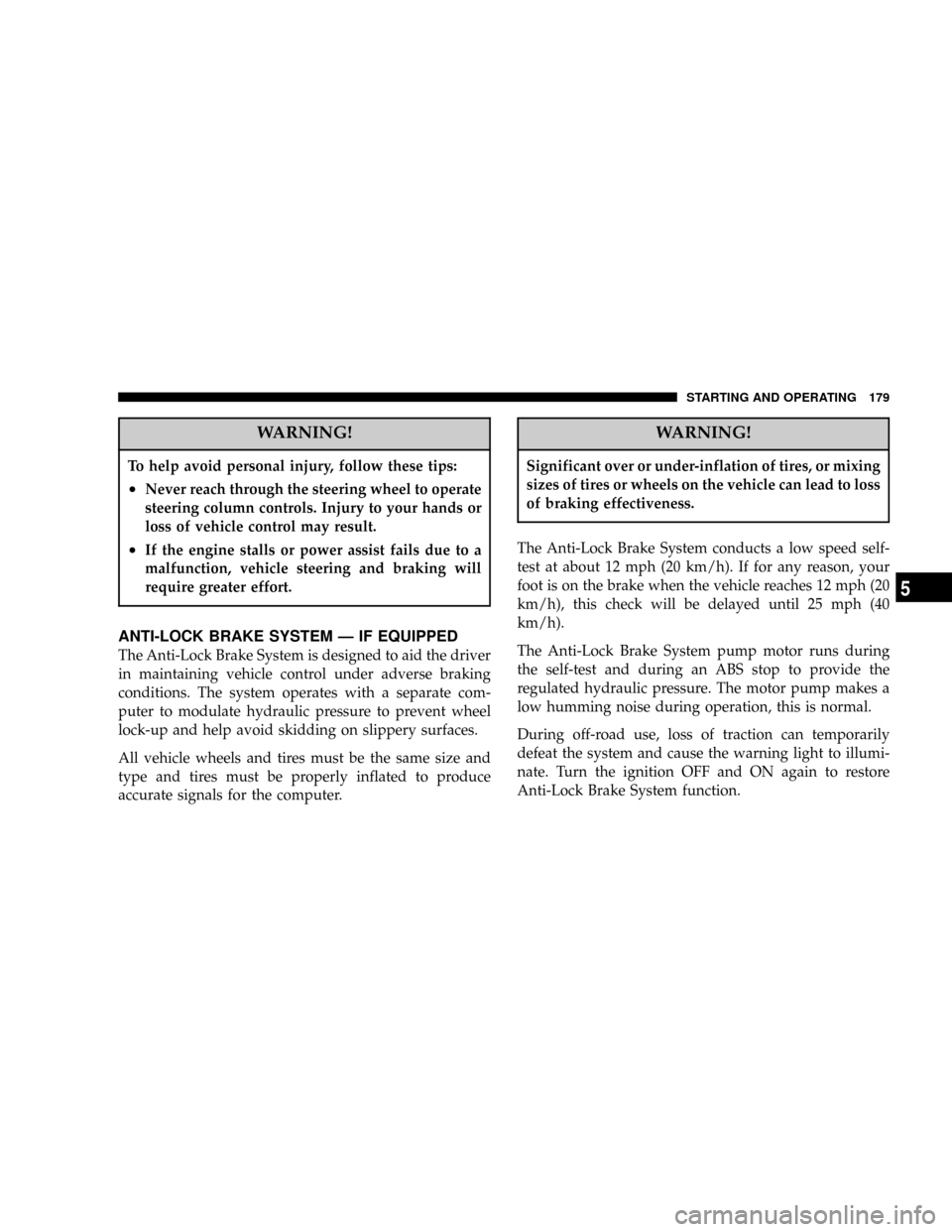tires JEEP WRANGLER 2004 TJ / 2.G Owners Manual
[x] Cancel search | Manufacturer: JEEP, Model Year: 2004, Model line: WRANGLER, Model: JEEP WRANGLER 2004 TJ / 2.GPages: 299, PDF Size: 6.82 MB
Page 41 of 299

Safety Checks You Should Make Inside The
Vehicle
Seat Belts
Inspect the belt system periodically, checking for cuts,
frays and loose parts. Damaged parts must be replaced
immediately. Do not disassemble or modify the system.
Seat belt assemblies must be replaced after an accident if
they have been damaged (bent retractor, torn webbing,
etc.). If there is any question regarding belt or retractor
condition, replace the belt.
Airbag Warning Light
The light should come on and remain on for 6 to 8
seconds as a indicator check when the ignition switch is
first turned on. If the indicator is not lit during starting,
have it serviced. If the light stays on or comes on while
driving, have the system checked by an authorized
dealer.
Defrosters
Check operation by selecting the defrost mode and place
the blower control on high speed. You should feel the air
directed against the windshield.
Safety Checks You Should Make Outside The
Vehicle
Tires
Examine tires for excessive tread wear or uneven wear
patterns. Check for stones, nails, glass, or other objects
lodged in the tread. Inspect for tread cuts or sidewall
cracks. Check wheel nuts for tightness and tires (includ-
ing spare) for proper pressure.
Lights
Have someone observe the operation of all exterior lights
while you work the controls. Check turn signal and high
beam indicator lights on the instrument panel.
Fluid Leaks
Check area under vehicle after overnight parking for fuel,
coolant, oil, or other fluid leaks. Also, if gasoline fumes
are detected, the cause should be located and corrected
immediately.
THINGS TO KNOW BEFORE STARTING YOUR VEHICLE 41
2
Page 78 of 299

26. Close the header latches and position the sun visor.HARD TOP
CAUTION!
²The hard top is not designed to carry any addi-
tional loads such as roof racks, spare tires, build-
ing, hunting, or camping supplies, and/or lug-
gage, etc. Also, it was not designed as a structural
member of the vehicle, and thus cannot properly
carry any additional loads other than environmen-
tal (rain, snow, etc.).
²The hard top does not include any devices to
properly secure any loads on the roof, and any
damage (structural or surface finish) that occurs
due to any additional loading to the top area will
void the vehicle warranty.
78 UNDERSTANDING THE FEATURES OF YOUR VEHICLE
Page 82 of 299

NOTE:If the doors are to be removed, pull the #4 fuse
from the fuse block to prevent dome lamp illumination.
Hard Top Installation
NOTE:
If the door frames are installed from soft top
usage, they must be removed prior to installation of the
hard top.
1. Inspect the hard top seals for damage and replace if
necessary.
2. Install the hard top using the same steps for removal
in reverse order.
NOTE:The hard top must be positioned properly to
ensure sealing. Set the hard top on the windshield frame
so that there is no overhang. Also, make sure that the
hard top is sitting flush with the body at the sides and
check to ensure that there is a uniform gap between the
lift glass and hard top.
SOFT TOP
CAUTION!
²The soft top is not designed to carry any addi-
tional loads such as roof racks, spare tires, build-
ing, hunting, or camping supplies, and/or lug-
gage, etc. Also, it was not designed as a structural
member of the vehicle, and thus cannot properly
carry any additional loads other than environmen-
tal (rain, snow, etc.).
²The soft top does not include any devices to
properly secure any loads on the roof, and any
damage (structural or surface finish) that occurs
due to any additional loading to the top area will
void any vehicle warranty.
82 UNDERSTANDING THE FEATURES OF YOUR VEHICLE
Page 158 of 299

mOff-Road Driving Tips..................181
NWhen To Use Low Range...............181
NIn Snow, Mud And Sand................181
NHill Climbing........................182
NTraction Downhill.....................183
NAfter Driving Off-Road.................183
mTire Safety Information..................184
NTire Markings........................184
NTire Identification Number (TIN)..........187
NTire Loading And Tire Pressure...........188
mTires Ð General Information..............191
NTire Pressure.........................191
NTire Inflation Pressures.................192
NHigh Speed Operation.................193
NRadial-Ply Tires......................193NTire Spinning........................193
NTread Wear Indicators..................194
NReplacement Tires.....................194
NAlignment And Balance.................195
mTire Chains...........................196
mTire Rotation Recommendations...........196
mFuel Requirements.....................197
NReformulated Gasoline.................198
NGasoline/Oxygenate Blends..............198
NMMT In Gasoline.....................198
NSulfur In Gasoline.....................199
NMaterials Added To Fuel................199
mFuel Filler Cap (Gas Cap)................200
NLocking Fuel Filler Cap (Gas Cap) Ð
If Equipped.........................202
158 STARTING AND OPERATING
Page 171 of 299

NOTE:Do not attempt to make a shift while only the
front or rear wheels are spinning. The transfer case is not
equipped with a synchronizer and therefore the front and
rear driveshafts speeds must be equal for the shift to take
place. Shifting while only the front or rear wheels are
spinning can cause damage to the transfer case.
When operating your vehicle in 4L, the engine speed is
approximately three times that of the 2H or 4H positions
at a given road speed. Take care not to overspeed the
engine and do not exceed 25 mph (40 km/h).
Proper operation of four wheel drive vehicles depends on
tires of equal size, type, and circumference on each
wheel. Any difference will adversely affect shifting and
cause damage to the transfer case.
Because four wheel drive provides improved traction,
there is a tendency to exceed safe turning and stopping
speeds. Do not go faster than road conditions permit.WARNING!
You or others could be injured if you leave the
vehicle unattended with the transfer case in the N
(Neutral) position without first fully engaging the
parking brake. The transfer case N (Neutral) position
disengages both the front and rear driveshafts from
the powertrain and will allow the vehicle to move
regardless of the transmission position. The parking
brake should always be applied when the driver is
not in the vehicle.
Shift Positions
For additional information on the appropriate use of each
transfer case mode position, see the information below:
2H Position
Rear Wheel Drive High Range Ð Normal street and
highway driving. Dry hard surfaced roads.
STARTING AND OPERATING 171
5
Page 179 of 299

WARNING!
To help avoid personal injury, follow these tips:
²Never reach through the steering wheel to operate
steering column controls. Injury to your hands or
loss of vehicle control may result.
²If the engine stalls or power assist fails due to a
malfunction, vehicle steering and braking will
require greater effort.
ANTI-LOCK BRAKE SYSTEM Ð IF EQUIPPED
The Anti-Lock Brake System is designed to aid the driver
in maintaining vehicle control under adverse braking
conditions. The system operates with a separate com-
puter to modulate hydraulic pressure to prevent wheel
lock-up and help avoid skidding on slippery surfaces.
All vehicle wheels and tires must be the same size and
type and tires must be properly inflated to produce
accurate signals for the computer.
WARNING!
Significant over or under-inflation of tires, or mixing
sizes of tires or wheels on the vehicle can lead to loss
of braking effectiveness.
The Anti-Lock Brake System conducts a low speed self-
test at about 12 mph (20 km/h). If for any reason, your
foot is on the brake when the vehicle reaches 12 mph (20
km/h), this check will be delayed until 25 mph (40
km/h).
The Anti-Lock Brake System pump motor runs during
the self-test and during an ABS stop to provide the
regulated hydraulic pressure. The motor pump makes a
low humming noise during operation, this is normal.
During off-road use, loss of traction can temporarily
defeat the system and cause the warning light to illumi-
nate. Turn the ignition OFF and ON again to restore
Anti-Lock Brake System function.
STARTING AND OPERATING 179
5
Page 180 of 299

WARNING!
Pumping of the Anti-Lock Brakes will diminish
their effectiveness and may lead to an accident.
Pumping makes the stopping distance longer. Just
press firmly on your brake pedal when you need to
slow down or stop.
WARNING!
²Anti-lock system (ABS) cannot prevent the natu-
ral laws of physics from acting on the vehicle, nor
can it increase braking or steering efficiency be-
yond that afforded by the condition of the vehicle
brakes and tires or the traction afforded.
²The ABS cannot prevent accidents, including
those resulting from excessive speed in turns,
following another vehicle too closely, or hydro-
planing. Only a safe, attentive, and skillful driver
can prevent accidents.
²The capabilities of an ABS equipped vehicle must
never be exploited in a reckless or dangerous
manner which could jeopardize the user's safety
or the safety of others.
180 STARTING AND OPERATING
Page 182 of 299

Don't shift to a lower gear than necessary to maintain
headway. Over-revving the engine can spin the wheels
and traction will be lost.
Do not downshift on icy or slippery roads because engine
braking may cause skidding and loss of control.
When driving on soft sand, reduce your tire pressure to
15 psi (103 kPa) minimum to allow greater tire surface
area. You must return the tires to normal air pressure
before driving on pavement or other hard surfaces.
NOTE:Reduced tire pressures below 15 psi (103 kPa)
may cause tire unseating and loss of air pressure.
Hill Climbing
Before climbing a steep hill,change transmission to a
lower gear and shift the transfer case to 4L (Low). Use
first gear and 4L (Low) for very steep hills.
If you stall or begin to lose headwaywhile climbing a
steep hill, allow your vehicle to come to a stop and
immediately apply the brake. Restart the engine and shift
to R (Reverse). Back up slowly down the hill allowing the
compression braking of the engine and transmission tohelp regulate your speed. If the brakes are required to
control vehicle speed, apply them lightly and avoid
locking or skidding the tires.
WARNING!
If the engine stalls or you lose headway or cannot
make it to the top of a steep hill or grade, never
attempt to turn around. To do so may result in
tipping and rolling the vehicle. Always back care-
fully straight down a hill in R (Reverse) gear. Never
back down a hill in N (Neutral) or with the clutch
pedal depressed, using only the brake.
Remember, never drive diagonally across a hill, always
drive straight up or down.
If the wheels start to slip as you approach the crest of a
hill, ease off the accelerator and maintain headway by
turning the front wheels sharply left and right. This will
provide fresh ªbiteº into the surface and will usually
provide traction to complete the climb.
182 STARTING AND OPERATING
Page 183 of 299

Traction Downhill
Shift the transmission into a low gear and transfer case to
4L (Low) range. Let the vehicle go slowly down the hill
with all four wheels turning against engine compression
drag. This will permit you to control the vehicle speed
and direction.
After Driving Off-Road
Off-road operation puts more stress on your vehicle than
does most on-road driving. After driving off-road, it is
always a good idea to check for damage.
²Completely inspect the underbody of your vehicle.
Check tires, body structure, steering, suspension, and
exhaust system for damage.
²Check threaded fasteners for looseness, particularly on
the chassis, drivetrain components, steering, and sus-
pension. Retighten them, if required, and torque to the
values specified in the Service Manual.
²Check for accumulations of plants or brush. These
things could be a fire hazard, or they might hide
damage to fuel lines, brake hoses, axle pinion seals,
and propeller shafts.
²After extended operation in mud, sand, water, or
similar dirty conditions, have brake drums, brake
linings, and axle yokes inspected and cleaned as soon
as possible.
WARNING!
Abrasive material in any part of the brakes may
cause excessive wear or unpredictable braking. You
might not have full braking power when you need it
to prevent an accident. If you have been operating
your vehicle in dirty conditions, get your brakes
checked and cleaned as necessary.
²If you experience unusual vibration after driving in
mud, slush or similar conditions, check the wheels for
packed material. Packed foreign material can cause a
wheel imbalance and freeing the wheels will correct
the situation.
STARTING AND OPERATING 183
5
Page 184 of 299

TIRE SAFETY INFORMATION
Tire Markings
NOTE:
P(Passenger)-Metric tire sizing is based on U.S.
design standards. P-Metric tires have the letter ªPº
molded into the sidewall preceding the size designation.
Example: P215/65R15 95H.
NOTE:European Metric tire sizing is based on Euro-
pean design standards. Tires designed to this standard
have the tire size molded into the sidewall beginning
with the section width. The letter9P9is absent from this
tire size designation. Example: 215/65R15 96H
NOTE:LT(Light Truck)-Metric tire sizing is based on
U.S. design standards. The size designation for LT-Metric
tires is the same as for P-Metric tires except for the letters
ªLTº that are molded into the sidewall preceding the size
designation. Example: LT235/85R16.
NOTE:Temporary Spare tires are high pressure com-
pact spares designed for temporary emergency use only.
Tires designed to this standard have the letter ªTº
molded into the sidewall preceding the size designation.
Example: T145/80D18 103M.
NOTE:High Flotation tire sizing is based on U.S.
design standards and begins with the tire diameter
molded into the sidewall. Example: 31x10.5 R15 LT.
184 STARTING AND OPERATING